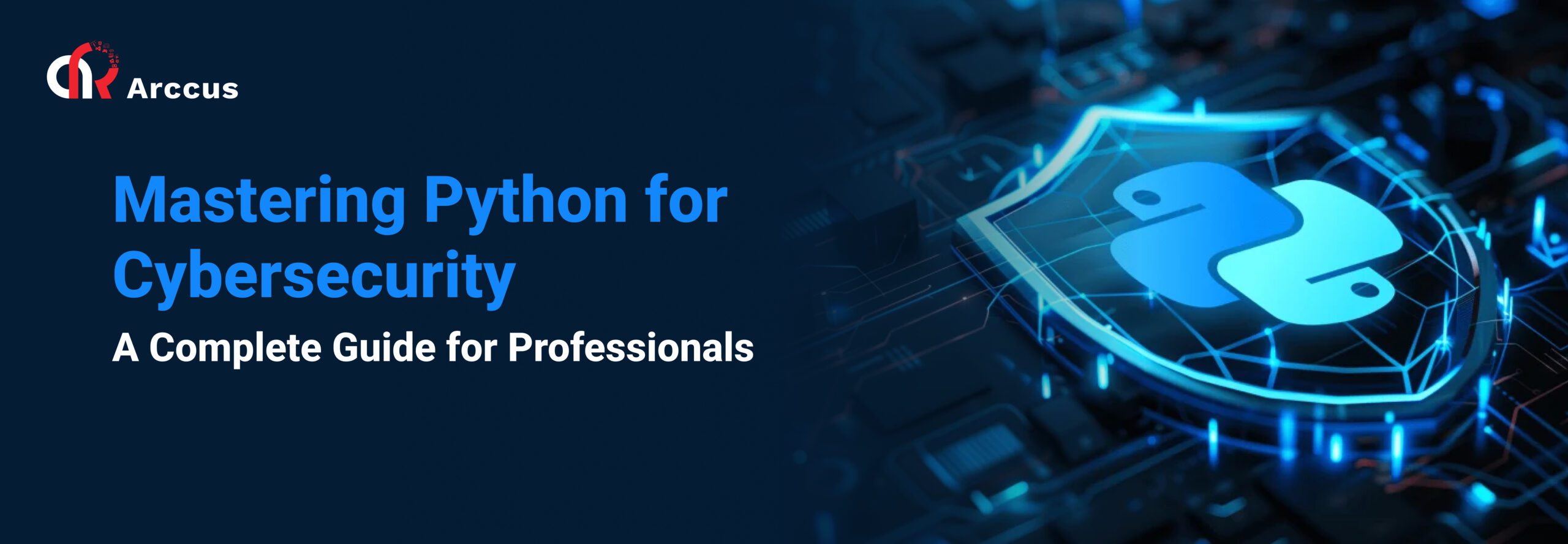Mastering Python for Cybersecurity: A Complete Guide for Professionals

In today’s digital battlefield, where threats lurk in every corner of the internet, cybersecurity professionals need tools that are not just effective but also adaptable, scalable, and fast. Python has quietly emerged as the go-to language for cyber warriors worldwide.
Python’s clean syntax, powerful libraries, and immense community support have made it a darling of the cybersecurity world. Whether you’re scripting a quick firewall rule, sniffing packets, or reverse-engineering malware, Python offers the perfect blend of speed and simplicity.
This guide walks you through the how, why, and what of mastering Python for cybersecurity, transforming you from a casual coder to a cyber sentinel.
Why Python for Cybersecurity?
The security landscape demands versatility. Python delivers it in abundance.
- Ease of Learning: Python’s intuitive syntax and readability make it accessible, even for professionals who don’t come from a traditional programming background.
- Flexibility: Do you need to automate a tedious task? Analyse logs? Craft custom exploits? Python can do it all.
- Rich Ecosystem: With libraries like Scapy, Requests, Paramiko, and Impacket, Python gives you plug-and-play power.
- Cross-Platform Compatibility: Run your scripts seamlessly on Windows, Linux, or macOS—no hassle.
- Community Backing: Thousands of open-source tools, extensive documentation, and a bustling GitHub scene make Python an evolving force.
Core Python Concepts Every Security Professional Should Know
To harness Python effectively in cybersecurity, you must first master its core components:
- Scripting and Automation: Write scripts to automate vulnerability scans, generate reports, or respond to alerts.
- File Handling: Parse access logs, inspect system configurations, and store audit results efficiently.
- Regular Expressions: Use regex to hunt down IP addresses, email patterns, hash formats, and suspicious strings.
- Networking Basics: Leverage socket to create raw connections, send data packets, or listen to ports.
- Error Handling: Robust try-except structures ensure your scripts don’t crash mid-operation.
- Multi-threading: Accelerate brute-force attempts or port scans by running tasks concurrently.
Get to Know more on Python Programming for Security
Essential Python Libraries for Cybersecurity

Python has become a cornerstone of modern cybersecurity, favored for its simplicity, readability, and vast ecosystem of libraries tailored to security tasks. Think of these libraries as your digital toolkit—each one a powerful weapon to help you analyze, protect, and defend systems.
Below are some indispensable Python libraries every cybersecurity professional should be familiar with:
-
Scapy
Scapy is a powerful Python-based interactive packet manipulation program. It’s popular for sniffing, crafting, spoofing and network discovery. Scapy is used for penetration testing, network mapping and vulnerability scanning by cybersecurity specialists.
-
Socket
The socket library provides access to the low-level networking interface of the host operating system. Creating custom server-client apps, port scanners, or basic network tools requires it. It offers flexibility for custom security utilities but requires more human development than higher-level libraries.
-
Requests & BeautifulSoup
These libraries collaborate on web tasks. Requests simplifies HTTP requests and handling, making it perfect for web APIs and browser simulation. BeautifulSoup makes HTML and XML data parsing and extraction easy. Both are useful for site scraping, reconnaissance, and automated vulnerability testing.
-
Paramiko
Paramiko, a Python SSHv2 implementation, allows secure remote machine connections. It’s used to automate system administration, run remote commands, and administer server infrastructure without exposing credentials.
-
Impacket
Impacket provides low-level programmatic access to Windows-relevant network protocols like SMB, NTLM, and Kerberos. Pass-the-hash, relay, and other attacks are common in penetration testing and red team engagements.
-
Cryptography/PyCrypto
These libraries provide strong cryptographic primitives for data encryption and security. PyCrypto (now obsolete but still used in legacy code) is still used, but cryptography is recommended for modern applications. Secure communication methods, password hashing, and data integrity require these technologies.
-
Volatility
Volatility analyzes hacked system memory dumps. The tool of choice for malware analysts, incident responders, and digital forensic investigators. It extracts processes, finds hidden services, and detects memory-based malware.
Analyse more on Python Security Tools
Real-World Applications of Python in Cybersecurity

Python’s real magic lies in its application. Here’s how professionals use it daily:
1. Penetration Testing
Automate payload generation, simulate phishing attacks, and perform vulnerability scans. Python for penetration testing can scan networks, brute-force credentials, and exploit common weaknesses.
Example: Build a basic port scanner using sockets and threading to identify open services across a network.
2. Threat Intelligence
Scrape threat feeds, extract indicators of compromise (IOCs), and correlate data from multiple sources.
Example: Use Requests and BeautifulSoup to collect and analyze real-time CVE information.
3. Network Security Monitoring
Deploy scripts that continuously sniff packets, log anomalies, and flag potential intrusions.
Example: Leverage Scapy to detect DNS tunneling or malformed packets.
4. Malware Analysis
Deconstruct malicious scripts; automate sandboxing; and analyse encoded payloads.
Example: Write a decoder to unravel base64 or XOR-obfuscated payloads found in malware.
5. Digital Forensics
Extract metadata from files, analyze memory dumps, and review login attempts with automated scripts.
Example: Use Volatility with Python plugins to inspect volatile memory for process injection.
Building Python Tools for Security Tasks
Once you grasp the fundamentals, the next step is the creation of python security tools. Here are some project ideas to start building your toolkit:
- Custom Port Scanner: Use a socket to build a multi-threaded scanner that identifies live hosts and services.
- Log Analyzer: Parse server logs to highlight unauthorized login attempts or anomalies.
- SSH Automation Tool: With paramiko, automate bulk tasks on remote machines—ideal for patch management or file transfers.
- Web Scraper for CVE Alerts: Stay ahead of threats by scraping security sites and summarising new vulnerabilities.
Each python security tool you create can be modularised, documented, and eventually scaled up into part of a larger security framework.
Best Practices for Using Python in Cybersecurity

Python is a powerful ally in the cybersecurity toolbox, widely used for scripting, automation, penetration testing, malware analysis, and more. However, with great power comes great responsibility.
To ensure your Python scripts are both effective and secure in high-stakes environments, follow these best practices:
-
Secure Your Scripts
Avoid storing sensitive information—like API keys, passwords, and tokens—directly in your source code. Hardcoding credentials can lead to serious security breaches, especially if the code is shared or pushed to a public repository.
Best Practices:
1) Use environment variables to manage credentials dynamically.
2) Leverage secure secrets management solutions such as HashiCorp Vault, AWS Secrets Manager, or python-dotenv.
3) Consider encrypting configuration files and decrypting them at runtime.
-
Follow Legal Guidelines
Cybersecurity work often involves scanning networks, probing systems, or simulating attacks. Even with good intentions, crossing legal boundaries can lead to severe consequences.
Best Practices:
1) Always have explicit permission (written if possible) before testing any system.
2) Stay updated on laws like the Computer Fraud and Abuse Act (CFAA) or GDPR, depending on your region.
3) Document your scope of work and maintain logs of actions taken during engagements.
-
Test in Isolated Labs
Before deploying your scripts or tools in a real-world environment, validate them thoroughly in a controlled lab environment.
Best Practices:
1) Use virtual machines or sandbox environments (e.g., VirtualBox, VMware, Docker) to test.
2) Simulate realistic network conditions with platforms like Cyber Range or TryHackMe.
3) Monitor for unintended behaviours or impacts that could disrupt real systems.
Want more details? Ping us anytime
-
Version Control
Tracking changes in your scripts is critical, especially when working in teams or over extended periods.
Best Practices:
1) Commit changes regularly with meaningful messages.
2) Use .gitignore to exclude sensitive files or logs.
3) Consider using private repositories for sensitive projects (e.g., GitHub private repos or self-hosted GitLab).
-
Virtual Environments
Python projects often require specific packages or versions. Isolating these dependencies avoids conflicts and ensures reproducibility.
Best Practices:
1) Use venv or virtualenv to create isolated environments.
2) Document dependencies in a requirements.txt file.
3) For advanced dependency management, consider using pipenv or Poetry.
FINAL VERDICT:
Python is no longer just an optional skill for cybersecurity professionals—it’s an essential weapon in the digital age. From building tools to analysing threats and automating defences, Python allows you to work smarter, respond faster, and stay one step ahead of adversaries.
Start small, stay curious, and code with purpose. Your journey toward Python mastery is not just about syntax—it’s about becoming a more effective guardian of cyberspace.
The code is your shield. Wield it wisely.